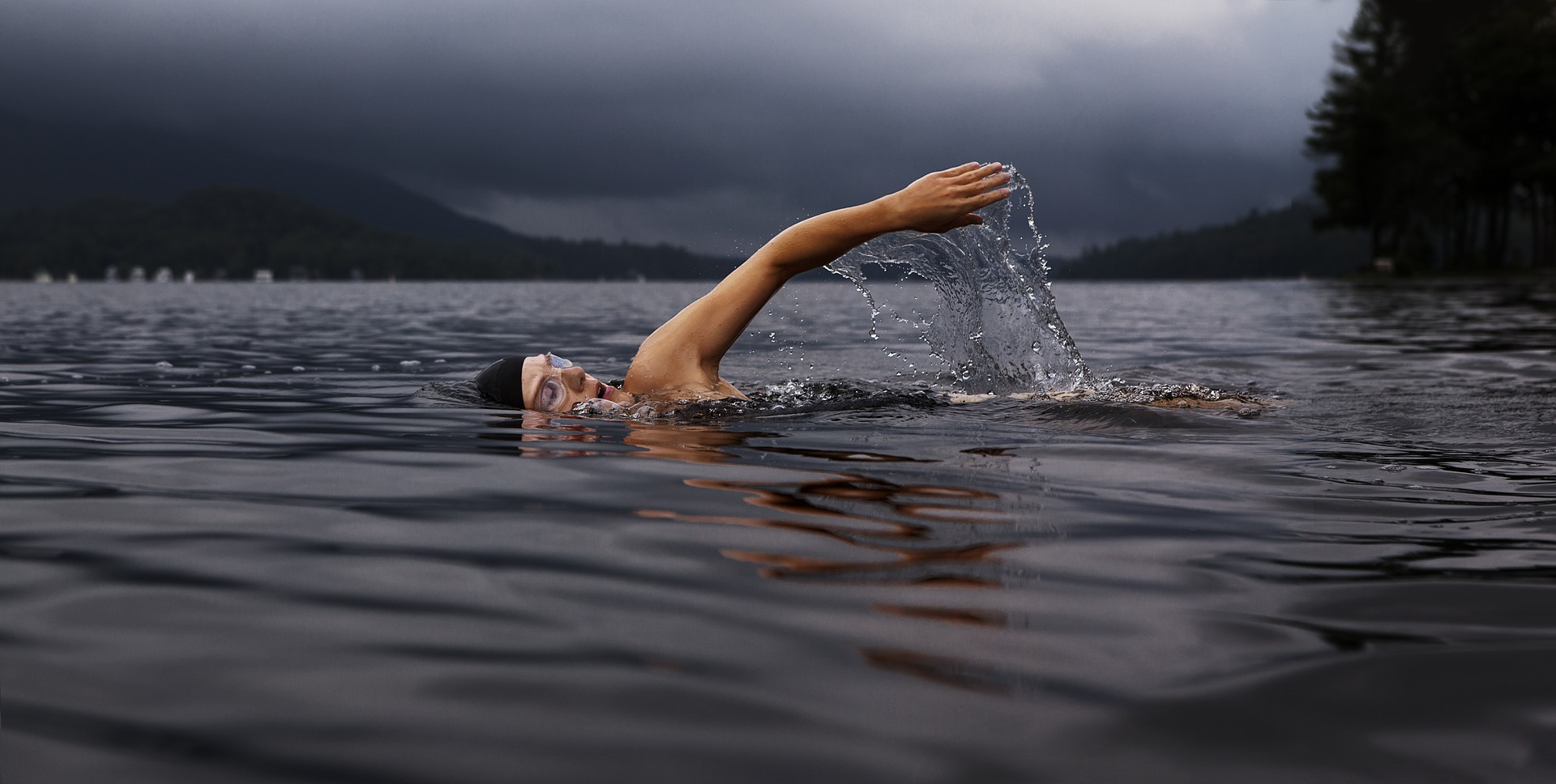A Stroke Cadence In Time - Part One
by Coach Emmett Hines
Stroke Cadence: you likely have a range of stroke counts (number of strokes per length of the pool, or SPL) which you can execute in a smooth swimming rhythm. You likely also work to expand that range, seeking to increase distance per stroke (DPS) in order to be able to complete a length in fewer strokes.
But if speed is an issue, DPS is only half of the equation. The other half is tempo (how often you take a stroke – stroke cadence). Most swimmers tend to use one tempo for each of the stroke counts in their range. But really good swimmers develop a range of tempos (stroke cadences) for each of the stroke counts they use in training and competition - they work on executing each different stroke count (stroke cadence)at faster and faster tempos.
Striving for ever lower stroke counts (stroke cadence) is about learning, refining and ingraining proper posture, streamlining, motion and timing skills. These skills can then be incorporated at higher stroke counts and at faster tempos. For instance, if you learn a new skill that makes a stroke more propulsive and helps to take your lowest achievable stroke count from, say, 14 to 13 SPL at a slow tempo, chances are that same skill will be more propulsive and serve you well at, say, 17 SPL at a faster tempo.
There are a few key things to remember about the relationship of DPS and tempo:
- Your lowest stroke count will only be available to you at a single, slow tempo (i.e. you can competently and confidently repeat the skill at that tempo only).
- At every higher stroke count there is a range of tempos that are possible for you.
- The further you get from your lowest stroke count, the wider that range of possible tempos is (like the wake behind a moving boat).
- Every time you learn new or refine existing skills that help you establish a new lowest stroke count, the possible tempo ranges at each of your higher stroke counts expands (again, like the wake expands behind that boat).
- That these tempos are possible, however, doesn’t mean they are immediately available for your use. For each stroke count (stroke cadence) you use, you must develop the tempo range in order for it to be truly available to you when needed.
Your Stroke Cadence Toolbox
In your garage you likely have a toolbox that comes in handy when tackling various maintenance jobs around the homestead. You likely have a range of socket sizes to fit your socket wrench, a range of bits and/or blades to fit each power tool, several types and sizes of screwdrivers, etc. Regardless of the task at hand, a well-stocked toolbox improves your chances of successful completion.

Envision coming each day to the water’s edge with a “swimming toolbox” containing a ready assortment of well-oiled swimming “tools” available for use. We can think of each DPS&Tempo combo you are capable of as a tool in your swimming toolbox. For each stroke tempo you are comfortable with, you should have a range of DPS you can do. And at each DPS you are capable of, you should have a range of stroke tempos (stroke cadences) you can do. Each new DPS&Tempo combo you develop fully becomes a new tool in your swimming toolbox.
Choosing the Right Tools for the Job
For any given swimming job (say, sprinting a 50) you will find that there is one tool (or small set of tools) that reliably produces the best product (the finish time on the clock). For another swimming job (say, swimming 5k in open water) there will be a different tool (or small set of tools) that reliably yields the best result. And just as with the toolbox in your garage, you will find that some of your swimming tools are more useful than others.
Using the wrong tool for a particular job can have undesirable results. For instance, choosing to swim around Manhattan Island with really short fast choppy strokes might end up being similar to grabbing an old pair of Vise-Grip pliers to remove a firmly seated bolt – what you end up with is a still-firmly-seated-but-now-rounded-off bolt and a small pile of nice shiny steel shavings - not the desired picture when all is done.
Understand the Tradeoffs
How fast you move through the water when taking strokes depends on only two easily quantifiable variables: the distance you travel with each stroke (DPS) and how often you take a stroke (tempo) - stroke cadence. When multiplied together, the result is speed. Want to swim faster? Simply choose a faster tempo for the DPS you currently use, or take longer strokes at your usual tempo, or go longer strokes and a faster tempo. It looks simple on paper:
Swimming Speed = DPS x Tempo
But this simplicity dissolves quickly in water. Assuming you have at least the rudimentary skills needed to complete the required distance without undue physical stress, managing the inherent tradeoffs between striving for faster tempos and attempts to lengthen strokes becomes a critical success factor in getting you back on shore faster and fresher. Athletes skilled in managing the tempo vs DPS tradeoff can make far more effective use of energy over a wide range of swimming speeds.
I said that both DPS and tempo are easily quantifiable. You already know that stroke counting gives you lap by lap feedback about DPS. But what about tempo? Most swimmers are only aware of relative tempo – “that 100 was a slightly faster tempo than the preceding one and I’ll make the next one an even faster tempo” – and many swimmers have an even less sophisticated tempo awareness – “that was my ‘fast’ tempo” or “I’ll go this one at my ‘easy’ tempo”. With such imprecise tempo knowledge, managing the tempo vs DPS tradeoff is crude guesswork at best.
It is possible to use the clock, your stroke count, your breakout distance and some rather involved calculation to determine your average tempo after a swim. But unless you are Rainman or Good Will Hunting, it isn’t very practical and it cannot give you stroke-by-stroke feedback.
Manage the Tradeoffs
What we really want is precise real-time stroke tempo feedback – with hard numbers to reference. This can be had by way of a minutely adjustable metronome/beeper worn under the cap or goggle strap. One such device is the Tempo Trainer from Finis (www.finisinc.com), available at local swim shops. Setting a precise tempo on the beeper, then syncing strokes to that tempo, gives far greater ability to experiment with and manage the tempo vs DPS tradeoffs.
Small, precise changes of beeper tempo allow a swimmer to change stroke tempo in very small increments (as small as 1/100th of a second per stroke). Such changes are small enough to be indiscernible from stroke to stroke, which allows the swimmer to remain focused on maintaining DPS. Such “baby steps” are important because a discernable tempo increase is generally much too large a step to take when exploring the outer edge of tempo range at any given stroke count – large enough to cause stroke execution to deteriorate (resulting in less DPS and more SPL). Regular use of a beeper shortens and flattens the learning path to both higher stroke tempos without shortening strokes and lower stroke counts without decreasing tempo – and both result in faster speeds.
Get Thee A Beeper
So go buy, beg, borrow or steal a beeper…well, don’t actually steal one, but you get the point. Once you do, the exercises in the rest of this series will teach you to manage the tradeoffs inherent to navigation of the tempo vs. DPS gauntlet. To see what’s in store - read A Stroke In Time - Part 2. v








